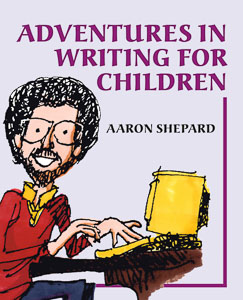Writing, they say, is a lonely profession. But there are ways to ease that. You can join a critique group. You can go to conferences. You can become a storyteller.
I have found storytelling to be a wonderful way to get away from the computer and come face to face with charmed and charming children, so eager to hear the stories I offer. I may feel like the lowest of the low when rejection slips crowd my mailbox, but in front of the kids I am King.
Besides the psychic boost, telling traditional folktales has helped develop my picture book writing. This is largely because of what those tales leave out. Setting is seldom more than mentioned, while characterization is limited to broad strokes. Internal musings are nearly forbidden. Flashbacks don’t happen. Abstractions are taboo.
With the trappings removed, what’s left is elemental Story—action, dialog, and word play, relentlessly impelling the story on a direct path from beginning to end. This, of course, is the aim of the picture book writer. And I can’t help but get a feel for it when I learn and tell folktales.
Storytelling helps my writing even more directly by letting me test my own stories in performance. We authors are often warned that the kids we know don’t make good judges. But, let me tell you, a roomful of young strangers makes a very good judge. It lets me know each moment if the story is working. Then I can take the story back to the computer and strengthen it before the next trial-by-fire. The result is a 100% kid‑tested story.
I also find that practicing and performing a story-in-progress helps me come up with the simplest and most natural wording for what I want to say. The story becomes more readable, and a better candidate for bedtime and story hours.
In one case, I combined storytelling and writing in an even more integral way. This was when I retold the folktale, “The Boy Who Went Forth to Learn What Fear Was”—or, as I renamed it, “The Boy Who Wanted the Willies.” The story is set mainly in a haunted castle, where a string of scary visitors fails to make the least impression on a ridiculously fearless hero.
The problem I saw with the tale was that many of the original incidents wouldn’t click with today’s kids. I had to find ones that would.
So I began performing the story as an improvisation piece. I got the boy into the castle in the dead of night, the clock struck one, and “something very scary happened. What was it?” One of the kids would tell me, and then I would invent on the spot how the hero dealt with it. The clock would then strike two, and so on, until I was ready to wind up the story.
In this way, I got a list of about fifteen scary incidents that would work with today’s kids. When I was ready to put the story on disk, I just picked the best ones and stretched them a bit. (But I still perform the story as an improv. It’s more fun!)
Storytelling also helps me in promoting myself as a children’s writer. By going public, I’m creating an ever-larger audience for my children’s books, as well as opportunities for direct book sales. And my acquired skill in captivating crowds of squirrelly youngsters makes me a natural for author visits, writer workshops, and other such events.
One warning: Storytelling requires a large investment of time for finding and learning stories. As you get more serious, performances and marketing can also take big chunks. A writer with limited time might do better sticking to the keyboard.
But I’m not sure I could ever give it up. It’s too much fun. And I wouldn’t be the same writer without it.
